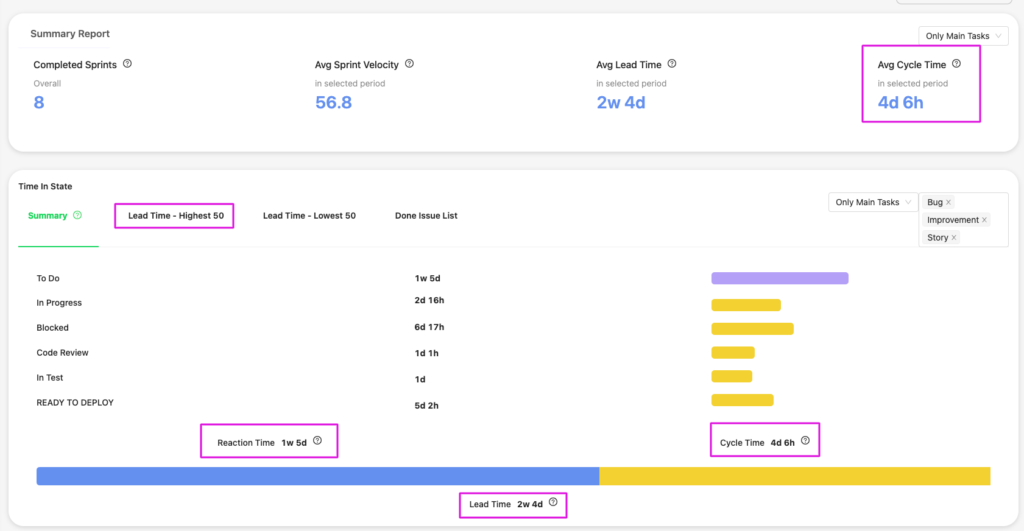What is Cycle Time?
Cycle time is a crucial metric in software development, measuring the time taken from the start of work on an item (such as a story, task, or bug) until it is ready for delivery. Knowing how to calculate cycle time provides valuable insights into the efficiency and productivity of your development process. By understanding cycle time, teams can gain a better perspective on their workflow, identify areas that need improvement, and ultimately deliver higher quality software faster.
Why is Cycle Time Important?
Understanding and optimizing cycle time is vital for several reasons:
- Efficiency: It helps identify bottlenecks and inefficiencies in the development process. When you can pinpoint where delays are occurring, you can take targeted actions to streamline your workflow.
- Predictability: It improves the predictability of delivery timelines. Accurate cycle time metrics enable teams to forecast delivery dates more reliably, enhancing planning and stakeholder confidence.
- Continuous Improvement: It supports continuous improvement by highlighting areas for process enhancements. Regularly monitoring cycle time can reveal trends and opportunities for making incremental changes that boost overall productivity.
- Customer Satisfaction: Faster delivery of high-quality software leads to increased customer satisfaction. Shorter cycle times mean that customers receive updates and new features more quickly, keeping them engaged and satisfied with the product.
How Do You Calculate Cycle Time?
Cycle time can be calculated using the following steps:
- Identify the Start and End Points: Determine when work starts (work in progress) and when it is completed (ready for delivery). This involves clearly defining the status changes that mark these points.
- Measure the Time Taken: Calculate the duration between these two points. This can be done manually or using software tools that track and record these times automatically.
In the Oobeya platform, cycle time is calculated within the Agile analytics module (AgileSpace) by connecting to tools like Jira Server, Jira Data Center, Jira Cloud, and Azure Boards. Oobeya calculates cycle time for each task or issue, highlighting the highest and lowest cycle times. Additionally, Oobeya provides comprehensive metrics that include Reaction Time and Lead Time, offering a more detailed view of the overall process efficiency.

Oobeya Cycle Time
What Are the Key Components of Cycle Time?
Understanding the key components of cycle time is essential for accurately measuring and improving your software development process. The primary components include:
- Coding Time: This is the period during which developers actively write code for a task or issue. It begins when a developer starts working on the coding task and ends when the code is ready for review. Efficient coding practices and clear requirements can help reduce coding time.
- Code Review Time: Once the coding is complete, the code enters the review stage. During this process, team members review the code for quality, adherence to standards, and potential issues. The time taken for reviews can vary depending on the complexity of the code and the thoroughness of the review process. Effective code review practices can help streamline this component.
- Continuous Integration Process: After, or as part of, the code review process, the other step is integration into the main code base. Continuous integration (CI) involves automatically building and testing the code to ensure that it integrates smoothly with the existing codebase. The length of this process depends on the efficiency of the CI tools and the complexity of the integration tasks.
- Testing and Validation Process: The final component is the testing and validation process, where the integrated code is thoroughly tested to identify and fix any bugs or issues. This includes various testing stages such as unit testing, integration testing, and user acceptance testing. Efficient testing strategies and automation can significantly reduce the time required for this component.
By focusing on these key components and continuously seeking improvements, teams can effectively reduce cycle time and enhance overall productivity.
What Are Common Challenges in Calculating Cycle Time?
Some common challenges include:
- Data Accuracy: Ensuring that start and end times are accurately recorded. Inaccurate data can lead to misleading cycle time calculations, affecting decision-making.
- Tool Integration: Seamlessly integrating with various project management tools. Different tools may have different ways of tracking time, making it challenging to consolidate data.
- Consistent Definitions: Maintaining consistent definitions of cycle time across teams. Without a shared understanding, comparing metrics between teams can be difficult.
- Handling Exceptions: Managing outliers and exceptional cases that can skew average cycle times. Special cases, such as particularly complex tasks, need to be handled separately to avoid distorting overall metrics.
How Can You Reduce Cycle Time?
To reduce cycle time, consider the following strategies:
- Streamline Processes: Simplify and automate workflows to eliminate unnecessary steps. Automation can significantly reduce the time spent on repetitive tasks.
- Improve Communication: Enhance team communication and collaboration to resolve issues faster. Clear and open communication channels can help prevent misunderstandings and delays.
- Identify Bottlenecks: Use data to identify and address bottlenecks in the development process. Regularly reviewing cycle time metrics can help pinpoint specific stages where delays occur.
- Prioritize Tasks: Focus on high-priority tasks to reduce waiting times and delays. Prioritizing work based on urgency and importance can help ensure that critical tasks are completed more quickly.
For a deeper understanding of cycle time and other key metrics, refer to our Oobeya Metric Definitions and learn how to Optimize Software Engineering with Oobeya.
The Oobeya platform, featured in the Gartner Market Guide for Software Engineering Intelligence Platforms, provides comprehensive insights into software development processes. It serves as a single source of truth for engineering data, offering a unified, comprehensive, and transparent view of engineering processes. By using Oobeya, teams can better understand how software solutions are built and delivered, see where they are spending time, and improve team flow through key metrics like DORA metrics and cycle time.
By leveraging these engineering insights, you can optimize software development processes, improve efficiency, and deliver higher quality software faster.